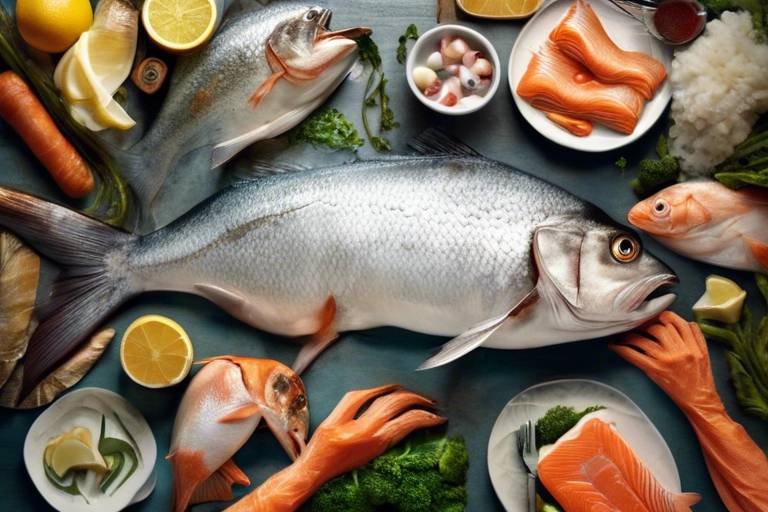Incorporating More Fish Into Your Family’s Diet
Are you looking for a way to boost your family's health while also tantalizing their taste buds? Look no further than incorporating more fish into your meals! Fish is not just a delightful addition to your dinner plate; it’s a nutritional powerhouse that offers a myriad of health benefits for all ages. Imagine your family enjoying delicious, flaky fillets of salmon or crispy fish tacos, all while knowing they’re fueling their bodies with essential nutrients. Sounds appealing, right?
But why fish, you ask? Well, fish is packed with omega-3 fatty acids, which are crucial for heart health, brain function, and even mood regulation. These healthy fats can help reduce inflammation and lower the risk of chronic diseases, making fish an excellent choice for your family's diet. Plus, it’s a versatile ingredient that can be prepared in countless ways, from grilling to baking, ensuring that you never get bored of it!
In this article, we will explore the benefits of including fish in your family's meals, along with practical tips and delicious recipes that will make it easy to incorporate this nutritious food into your weekly meal planning. We'll also dive into the importance of sustainability, so you can make informed choices that are good for both your family and the planet. So, let’s dive right in!
Fish is a true superfood. It’s loaded with essential nutrients that contribute to overall health and well-being. For instance, fish is an excellent source of high-quality protein, which is vital for growth and development in children and maintaining muscle mass in adults. Moreover, fish contains important vitamins and minerals such as vitamin D, B vitamins, and selenium, which play crucial roles in various bodily functions.
Perhaps the most talked-about benefit of fish is its high content of omega-3 fatty acids. These fats are known for their ability to:
- Support heart health: Omega-3s help lower blood pressure and reduce triglycerides, which can lead to a healthier heart.
- Enhance brain function: Regular consumption of fish is linked to improved cognitive function and may even reduce the risk of Alzheimer's disease.
- Boost mood: Omega-3s can help alleviate symptoms of depression and anxiety, contributing to better mental health.
Incorporating fish into your family's diet can be a game changer. Not only does it provide these essential nutrients, but it also opens up a world of culinary possibilities!
As we embrace the benefits of fish, it’s equally important to consider the impact of our choices on the environment. Sustainability is key when selecting fish. Overfishing and destructive fishing practices can lead to the depletion of fish populations and damage to marine ecosystems. Therefore, understanding how to make environmentally friendly choices is essential.
When shopping for fish, look for labels that indicate certified sustainable seafood. Organizations like the Marine Stewardship Council (MSC) and the Aquaculture Stewardship Council (ASC) provide certifications that ensure the fish you buy is sourced responsibly. Additionally, you can ask your local fishmonger about the sustainability of their products. They can often provide valuable insights into where the fish comes from and how it was caught or farmed.
Not all fish are created equal when it comes to sustainability. Here are some types of fish that are generally considered sustainable choices:
- Salmon: Look for wild-caught Alaskan salmon or responsibly farmed options.
- Sardines: These little fish are not only sustainable but also packed with omega-3s.
- Rainbow Trout: Farmed rainbow trout is often raised in environmentally friendly conditions.
- Tilapia: When farmed responsibly, tilapia can be a sustainable choice.
By choosing sustainable fish, you’re not only making a healthy choice for your family but also contributing to the health of our oceans.
The debate between wild-caught and farmed fish is ongoing. Each option has its pros and cons:
| Type | Pros | Cons |
|---|---|---|
| Wild-Caught | Natural diet, often higher in omega-3s | Overfishing concerns, availability issues |
| Farmed | Consistent supply, often more affordable | Can be lower in omega-3s, potential for antibiotics |
Ultimately, the choice depends on your personal preferences and values. Educating yourself about the sources of your fish can help you make the best decision for your family.
Eating fish that is in season and sourced locally not only enhances freshness and flavor but also supports local economies. Local fish markets often have the freshest catches available, and seasonal varieties can offer unique flavors that you might not find in imported fish. To find out what fish is in season in your area, check local fisheries or online resources.
Incorporating more fish into your family’s diet can be an exciting culinary adventure that brings health benefits and sustainability into your home. With the right knowledge and a few simple recipes, you can make fish a regular part of your meals!

Health Benefits of Fish
When it comes to nutrition, fish is often hailed as a true superstar. Packed with essential nutrients, fish serves as a delicious way to boost your family's health. One of the standout features of fish is its rich content of omega-3 fatty acids, which play a crucial role in maintaining heart health. These fatty acids are known to reduce inflammation, lower blood pressure, and even decrease the risk of heart disease. Imagine your heart as a well-oiled machine; omega-3s are the oil that keeps it running smoothly!
But that’s not all! Fish is also loaded with high-quality protein, which is vital for growth and development, especially in children. Think of protein as the building blocks of your body—without it, your family might feel sluggish and undernourished. Additionally, fish contains important vitamins and minerals, such as vitamin D and selenium, both of which support immune function and help keep bones strong.
Moreover, the consumption of fish has been linked to improved brain function. Studies suggest that regular intake of fish can enhance cognitive abilities and may even lower the risk of Alzheimer’s disease. It's like giving your brain a workout with every bite! The omega-3s found in fish are essential for brain health and are particularly important for young, developing minds. So, if you want your kids to ace their exams, consider serving up some salmon or mackerel for dinner!
It's also worth mentioning that fish can be beneficial for your mood. The nutrients in fish, particularly omega-3 fatty acids, have been shown to help reduce symptoms of depression and anxiety. Picture this: a family dinner featuring a tasty fish dish not only nourishes the body but can also uplift the spirit. Who wouldn’t want a meal that brings joy and health to the table?
To sum it up, incorporating fish into your family's diet is a delicious way to reap numerous health benefits. From heart health to brain function, the advantages are compelling. So, why not explore some fish recipes and make it a regular part of your meal planning? Your family will thank you for it!
| Nutrient | Benefits |
|---|---|
| Omega-3 Fatty Acids | Supports heart health, reduces inflammation |
| High-Quality Protein | Essential for growth and development |
| Vitamin D | Boosts immune function and maintains bone health |
| Selenium | Protects against oxidative stress |

Choosing Sustainable Fish
When it comes to incorporating fish into your family's diet, making sustainable choices is crucial, not just for your health, but also for the health of our planet. As fish populations dwindle due to overfishing and environmental changes, understanding how to choose sustainable options can make a significant difference. But what does "sustainable fish" really mean? In essence, it refers to fish that are caught or farmed in a way that ensures their populations can thrive and that the ecosystems they inhabit remain healthy.
One of the first steps in choosing sustainable fish is to educate yourself about fishing practices. Look for fish that are sourced from fisheries that follow responsible management practices. These fisheries aim to maintain fish populations at sustainable levels while minimizing the impact on the environment. You can often find this information on product labels or by checking resources like the Marine Stewardship Council (MSC) or the Monterey Bay Seafood Watch, which provide guides on sustainable seafood choices.
Another important aspect is recognizing certified sustainable seafood options. Many organizations provide certifications that indicate a fish product meets strict sustainability standards. These certifications can help you make informed decisions at the grocery store or fish market. When shopping, look for labels such as MSC Certified or Best Aquaculture Practices (BAP). These labels signify that the fish has been sourced responsibly.
Additionally, understanding the types of fish that are sustainable can guide your choices. Some popular sustainable fish options include:
- Alaskan Salmon - Known for its rich flavor and high omega-3 content.
- Sardines - Packed with nutrients and usually caught in a sustainable manner.
- Rainbow Trout - Often farmed sustainably and a great source of protein.
- Pacific Cod - A versatile fish that is typically caught sustainably.
By opting for these sustainable varieties, you are not only doing your part to protect the environment but also ensuring that your family enjoys the freshest and healthiest fish available. Remember, the choices you make at the market can have a ripple effect on our oceans and the communities that depend on them.
In conclusion, choosing sustainable fish is about more than just picking a product off the shelf. It's about being an informed consumer, understanding the impact of your choices, and contributing to a healthier planet. So, the next time you're at the seafood counter, take a moment to consider where that fish comes from and how it was caught or farmed. Your family—and the ocean—will thank you!
Q: What makes fish sustainable?
A: Sustainable fish are sourced from fisheries that maintain healthy fish populations and minimize environmental impact. Look for certifications like MSC or BAP.
Q: How can I find sustainable fish in my area?
A: Check local fish markets, grocery stores, or online resources like Seafood Watch for recommendations on sustainable seafood options available near you.
Q: Are farmed fish always sustainable?
A: Not all farmed fish are sustainable. It's essential to look for certifications that indicate responsible farming practices.

Types of Sustainable Fish
When it comes to incorporating fish into your family's diet, choosing sustainable options is essential not only for your health but also for the health of our oceans. Sustainable fish are caught or farmed in ways that maintain fish populations and the ecosystems they inhabit. This means you can enjoy your meals with a clear conscience, knowing you're making a positive impact. So, what are some types of sustainable fish that you can easily find at your local market or grocery store?
One of the best choices is Alaskan salmon. Known for its rich flavor and high omega-3 content, this fish is not only delicious but also comes from well-managed fisheries. Another excellent option is Pacific sardines, which are small, oily fish that are packed with nutrients and are often caught in a sustainable manner. They are versatile and can be used in salads, sandwiches, or grilled as a main dish.
Other sustainable fish options include:
- Rainbow trout - Farmed in freshwater environments, rainbow trout is a healthy choice that is generally raised in sustainable conditions.
- Baramundi - This fish is often farmed in eco-friendly systems and has a mild flavor that appeals to many palates.
- Cod - Look for Pacific cod, which is often caught using sustainable methods, unlike its Atlantic counterpart.
It's important to note that sustainability can vary based on the fishing practices and the specific region where the fish is sourced. Therefore, always check for certifications like the Marine Stewardship Council (MSC) label or the Aquaculture Stewardship Council (ASC) label, which indicate that the fish has been sourced responsibly.
Additionally, consider the seasonality of fish. Eating fish that is in season not only supports local fisheries but also ensures that you're getting the freshest product available. For example, during the summer months, you might find an abundance of mackerel and flounder, while winter is a great time for herring and pollock.
By choosing sustainable fish, you’re not just making a healthy choice for your family; you’re also contributing to the preservation of marine ecosystems. Next time you’re at the store, take a moment to consider the impact of your choices and opt for fish that are both nutritious and sustainable.
Q: What makes fish sustainable?
A: Sustainable fish are sourced in a way that doesn't harm the environment, ensuring fish populations remain stable and ecosystems are preserved.
Q: How can I identify sustainable fish at the store?
A: Look for labels such as the Marine Stewardship Council (MSC) or Aquaculture Stewardship Council (ASC) certifications, which indicate responsible sourcing.
Q: Are all types of farmed fish sustainable?
A: Not all farmed fish are sustainable. It's crucial to research the farming practices and choose brands that prioritize eco-friendly methods.
Q: Can I eat fish regularly without worrying about mercury?
A: Yes, many sustainable fish options have low mercury levels. However, it's always good to vary your choices and consult guidelines regarding fish consumption.

Wild-Caught vs. Farmed Fish
When it comes to choosing between wild-caught and farmed fish, the debate can be as heated as a summer barbecue! Each option has its own set of pros and cons, and understanding these can help your family make informed decisions that suit your lifestyle and values. Let's dive into the murky waters of this topic.
Wild-caught fish are typically seen as the gold standard in the seafood world. These fish are captured in their natural habitats, swimming freely in oceans, rivers, and lakes. One of the biggest advantages of wild-caught fish is their nutritional profile. They tend to have higher levels of omega-3 fatty acids, which are essential for heart health and brain function. Additionally, wild fish often have a more robust flavor and firmer texture, making them a hit at the dinner table.
On the flip side, farmed fish are raised in controlled environments, such as fish farms or aquaculture systems. This method of production allows for a more consistent supply of fish, which can be beneficial for families looking to include seafood in their diet regularly. However, the nutritional content of farmed fish can vary significantly. Some studies suggest that farmed fish may contain higher levels of omega-6 fatty acids and lower levels of omega-3s compared to their wild counterparts. Furthermore, concerns have been raised about the use of antibiotics and other chemicals in fish farming practices.
To help you weigh your options, here’s a quick comparison:
| Aspect | Wild-Caught Fish | Farmed Fish |
|---|---|---|
| Nutritional Value | Higher omega-3s, lower omega-6s | Varies; often higher omega-6s |
| Flavor and Texture | More robust flavor, firmer texture | Softer texture, milder flavor |
| Environmental Impact | Can deplete wild populations | Can cause habitat destruction if not managed |
| Cost | Generally more expensive | Usually more affordable |
Ultimately, the choice between wild-caught and farmed fish may come down to personal preference, budget, and values regarding sustainability. If you're concerned about environmental impact, look for fish labeled as sustainable or responsibly farmed. Many organizations provide certifications that can guide your purchasing decisions, ensuring that you’re making a choice that’s better for both your family and the planet.
In conclusion, whether you lean towards wild-caught or farmed fish, both options offer delicious and nutritious ways to incorporate seafood into your family’s meals. The key is to stay informed and choose wisely, making seafood a delightful and healthy part of your diet.

Seasonal and Local Fish
When it comes to enjoying fish, nothing beats the freshness and flavor of seasonal and local varieties. Eating fish that is in season not only enhances your meals but also supports local fisheries and reduces your carbon footprint. Imagine biting into a piece of fish that was swimming in the ocean just a few hours ago—now that’s a taste sensation that frozen or imported fish simply can’t replicate!
But how do you know what fish is in season? It can vary depending on your location, so it's essential to do a little research. Many local fish markets and seafood restaurants proudly display their seasonal offerings, and they can often share stories about where the fish was caught. You might be surprised at the variety available right in your backyard!
Here’s a quick guide to some common seasonal fish you might find:
| Fish Type | Season | Flavor Profile |
|---|---|---|
| Salmon | Spring to Fall | Rich and buttery |
| Tuna | Summer | Meaty and firm |
| Sardines | Late Spring to Early Fall | Strong and savory |
| Cod | Winter to Early Spring | Flaky and mild |
By choosing local fish, you’re not only getting a fresher product, but you’re also supporting your community. Local fisheries often practice sustainable fishing methods, ensuring that fish populations remain healthy and that the ecosystem is preserved for future generations. Plus, you get to enjoy the thrill of knowing exactly where your dinner came from!
For families looking to incorporate more fish into their diet, visiting a local fish market can be a fun outing. You can ask the fishmonger about the best seasonal catches and even learn about different cooking methods that will highlight the fish’s natural flavors. It’s a fantastic way to get the kids involved in the kitchen and teach them about where their food comes from.
So, next time you’re planning your meals, consider making a trip to your local market to see what seasonal fish are available. The freshness will elevate your dishes, and you'll feel good knowing you’re making environmentally friendly choices!
- What is the benefit of eating seasonal fish? Seasonal fish is fresher, tastier, and often more sustainable. It supports local fisheries and reduces the environmental impact associated with transporting fish over long distances.
- How can I find out what fish is in season? Check with local fish markets, seafood restaurants, or online resources that provide seasonal seafood guides based on your location.
- What are the best cooking methods for seasonal fish? Grilling, baking, and sautéing are excellent methods that bring out the natural flavors of seasonal fish. Each method can offer a unique taste and texture.

Easy Fish Recipes for Families
Cooking fish can be a delightful experience, especially when you have simple, mouthwatering recipes at your fingertips. Incorporating fish into your family's meals doesn't have to be an overwhelming task. In fact, you can whip up delicious fish dishes in no time! Here are a few easy recipes that are not only healthy but also kid-approved. Whether you're a seasoned chef or a kitchen novice, these recipes will make you feel like a culinary rock star.
First up is the Classic Baked Salmon. This dish is not just easy to prepare; it also boasts a rich flavor that appeals to everyone. Start by preheating your oven to 375°F (190°C). Place salmon fillets on a baking sheet lined with parchment paper, season them with salt, pepper, and a drizzle of olive oil. For an extra kick, add some fresh lemon slices and herbs like dill or parsley. Bake for about 15-20 minutes, and you’ll have a flaky, tender fish that pairs beautifully with steamed vegetables or a light salad.
Next, let’s talk about Fish Tacos. Kids love tacos, and these fish tacos are a fun way to introduce more seafood into their diet. You can use any white fish, like cod or tilapia. Simply season the fish with taco spices (think cumin, paprika, and chili powder) and grill or pan-fry until cooked through. Serve the fish in corn tortillas topped with shredded cabbage, diced tomatoes, and a zesty lime crema made from sour cream and lime juice. It’s a vibrant meal that’s sure to bring smiles to the dinner table!
If you’re looking for something quick and hearty, try Fish and Vegetable Stir-Fry. This dish is a fantastic way to use up any leftover veggies in your fridge. Start by cutting your favorite fish (salmon, tilapia, or shrimp work great) into bite-sized pieces. Sauté them in a hot pan with a splash of soy sauce, garlic, and ginger. Add in your veggies—think bell peppers, broccoli, and snap peas—and stir-fry until everything is cooked through. Serve it over brown rice or quinoa for a complete meal that’s bursting with flavor and nutrition.
Finally, don’t forget about Fish Chowder! This comforting dish is perfect for chilly evenings. Begin by sautéing onions, carrots, and celery in a large pot until they’re soft. Add diced potatoes, fish stock, and your choice of fish (cod, haddock, or even canned salmon). Let it simmer until the potatoes are tender, then stir in some cream for richness. Season with fresh herbs like thyme and serve with crusty bread for a cozy family dinner.
These recipes are just the tip of the iceberg when it comes to cooking fish at home. By keeping things simple and flavorful, you can help your family develop a taste for seafood. Plus, you’ll be introducing them to a world of healthy eating that can last a lifetime. Remember, the key to successful family meals is to make them enjoyable and stress-free. So, gather your loved ones in the kitchen, and let the fun begin!
1. How often should I serve fish to my family?
It's recommended to serve fish at least twice a week to reap the health benefits associated with omega-3 fatty acids.
2. What are some good side dishes to serve with fish?
Pair fish with a variety of sides such as steamed vegetables, quinoa, brown rice, or a fresh salad for a balanced meal.
3. How can I make fish more appealing to kids?
Involve kids in the cooking process and let them choose their favorite seasonings or toppings. Making fish tacos or fish sticks can also make it more fun!
4. Are there any fish that should be avoided due to high mercury levels?
Yes, larger fish like shark, swordfish, and king mackerel tend to have higher mercury levels. Opt for smaller fish such as sardines, salmon, or trout instead.

Overcoming Common Fish Myths
Many families shy away from incorporating fish into their meals, often due to a myriad of misconceptions that surround this nutritious food source. It's time to set the record straight! One of the most prevalent myths is that fish is always fishy in taste. In reality, when prepared correctly, fish can be a delightful addition to your dining table, bursting with flavor rather than that overwhelming "fishy" taste. Think of it like a well-cooked steak; if seasoned and cooked right, it’s a culinary delight!
Another common concern is about mercury levels in fish. Yes, some fish can contain higher levels of mercury, but this doesn't mean you should avoid fish altogether. The key is to choose wisely! For example, fish like salmon, sardines, and trout are not only lower in mercury but are also high in omega-3 fatty acids. The benefits of consuming fish far outweigh the risks when you make informed choices. To help you navigate these choices, here’s a quick table summarizing some common fish and their mercury levels:
| Fish Type | Average Mercury Level (ppm) | Recommended Frequency |
|---|---|---|
| Salmon | 0.022 | 2-3 times a week |
| Sardines | 0.013 | 2-3 times a week |
| Tuna (light) | 0.128 | Once a week |
| Tuna (albacore) | 0.358 | Once a month |
Another myth that often surfaces is that cooking fish is a complicated process that requires culinary expertise. This notion couldn’t be further from the truth! Cooking fish can be incredibly simple and quick. With techniques like grilling, baking, or sautéing, you can whip up a delicious fish dish in no time. For instance, a quick bake with herbs and lemon can transform a simple fillet into a gourmet meal. It’s like magic in the kitchen!
Finally, some families believe that eating fish is too expensive. While it’s true that some varieties can hit the wallet hard, there are plenty of affordable options out there. Look for frozen fish or check local markets for seasonal catches; these can often be more budget-friendly. Remember, you don’t have to break the bank to enjoy the health benefits of fish!
By dispelling these myths, we can encourage more families to embrace fish as a regular part of their diet. Not only does it offer incredible health benefits, but it can also be a fun and flavorful way to diversify your meals. So, the next time you’re planning dinner, consider reaching for some fish instead of defaulting to the usual chicken or beef!
- Is it safe for children to eat fish? Yes, fish is a great source of protein and omega-3 fatty acids, which are essential for children's development. Just be mindful of the types of fish you choose.
- How can I tell if fish is fresh? Fresh fish should have a clean, ocean-like smell, firm flesh, and bright, clear eyes. If it smells overly fishy, it’s best to avoid it.
- Can I eat fish if I’m pregnant? Yes, but it’s important to choose low-mercury options and consult with a healthcare provider for specific recommendations.

Cooking Techniques for Fish
Cooking fish can be a delightful experience, and it doesn't have to be daunting! With the right techniques, you can transform a simple piece of fish into a culinary masterpiece that your entire family will love. Whether you're a novice in the kitchen or a seasoned chef, understanding various cooking methods can elevate your fish dishes to new heights. So, let's dive into some popular techniques that will make cooking fish both easy and enjoyable!
One of the most popular methods is grilling. Grilling fish gives it a smoky flavor and a beautifully charred exterior. Think about it: the sizzle of the fish on the grill is music to the ears! To grill fish, simply preheat your grill, brush the fish with a little olive oil, season it with your favorite spices, and place it on the grill. Remember to keep an eye on it, as fish cooks quickly – usually around 3-5 minutes per side, depending on thickness. For added flavor, consider marinating the fish beforehand. A simple marinade of lemon juice, garlic, and herbs can work wonders!
Baking is another fantastic technique that allows for easy preparation and clean-up. To bake fish, preheat your oven to 375°F (190°C), place the fish on a baking sheet lined with parchment paper, and season it as you like. Bake for about 15-20 minutes, or until the fish is opaque and flakes easily with a fork. You can even add vegetables to the baking sheet for a complete meal! Just imagine the aroma wafting through your kitchen as the fish and veggies roast together.
If you're looking for a quick and healthy option, sautéing is your best friend. This method involves cooking fish in a hot pan with a little oil. The key is to get the pan hot enough so that the fish sears beautifully. Sautéing is perfect for thinner fillets like tilapia or sole, which cook in just a few minutes. Add a splash of white wine or lemon juice to the pan for an extra zing, and you’ll have a restaurant-quality dish in no time!
For those who love a crispy texture, pan-frying is a great choice. This technique involves cooking fish in a bit more oil than sautéing, allowing the outside to become golden and crunchy. Just be sure to use a non-stick skillet to prevent sticking. Coat your fish in breadcrumbs or flour for an added crunch, and fry until golden brown. The contrast of the crispy exterior with the tender fish inside is simply irresistible!
Lastly, don't overlook the wonders of steaming. This method retains the fish's moisture and nutrients, making it a healthy option. You can use a steamer basket over boiling water, or even the microwave for a quick steam. Just season your fish with herbs and spices, place it in the steamer, and let it cook for about 10 minutes. The result? A light and flaky dish that pairs beautifully with rice or steamed vegetables.
As you explore these cooking techniques, remember that fish is incredibly versatile. You can experiment with flavors, spices, and sides to create meals that cater to your family's tastes. The best part? Cooking fish can be a fun activity to do together, making mealtime a family affair!
- What is the best fish for grilling? Salmon, tuna, and swordfish are excellent choices for grilling due to their firm texture.
- How can I tell if my fish is cooked? Fish is done when it becomes opaque and flakes easily with a fork.
- Can I cook frozen fish? Yes, you can cook frozen fish directly from the freezer, but it may require a longer cooking time.
- What are some good seasonings for fish? Lemon, garlic, dill, and paprika are all fantastic options that enhance the flavor of fish.

Involving Kids in Fish Preparation
Getting your kids involved in the kitchen can be a fantastic way to not only bond as a family but also to instill healthy eating habits that will last a lifetime. When it comes to cooking fish, there are plenty of opportunities for little hands to help out, making the experience both educational and fun. Imagine the joy on their faces as they learn about different types of fish, how to prepare them, and the nutritional benefits they bring to the table!
Start by introducing your kids to the various types of fish you plan to cook. You could even create a mini fish “field trip” by visiting a local fish market or grocery store. Let them pick out their favorite fish, and discuss what makes each type unique. This not only piques their interest but also gives them a sense of ownership over the meal. When they are involved in choosing the ingredients, they are more likely to be excited about eating the final dish.
Once you’re back in the kitchen, turn the preparation process into a fun learning activity. Here are a few ideas to get your children engaged:
- Cleaning the Fish: Depending on their age, kids can help rinse the fish under cold water. You can explain the importance of cleanliness in food preparation.
- Seasoning: Allow them to sprinkle herbs and spices on the fish. This is a great way to teach them about flavors and how different seasonings can enhance the taste of a dish.
- Measuring Ingredients: If your recipe calls for marinades or sauces, let them measure out the ingredients. This can be a fun math lesson disguised as cooking!
- Setting the Table: Involve them in the final touches by letting them set the table or decorate the dining area. This adds an element of celebration to your meal.
Cooking fish can also be a fantastic opportunity to discuss nutrition. Talk to your kids about the benefits of omega-3 fatty acids and how fish contributes to a healthy diet. You might say, “Did you know that eating fish can help our brains grow stronger?” This kind of conversation not only educates them but also reinforces the idea that healthy food can be delicious and fun!
Lastly, don’t forget to celebrate your culinary achievements together. After cooking, sit down as a family and enjoy the meal you’ve created. Encourage your kids to share their thoughts on the dish and what they enjoyed about the cooking process. This can lead to a deeper appreciation for food and cooking, making them more likely to want to help out in the kitchen in the future.
Involving kids in fish preparation is not just about making dinner; it’s about creating lasting memories and fostering a love for healthy eating. So roll up your sleeves, put on those aprons, and dive into the delightful world of cooking fish together!
Q: Is it safe for kids to handle raw fish?
A: Yes, it is generally safe for kids to handle raw fish as long as they wash their hands thoroughly before and after. Always supervise them closely to ensure they practice good hygiene.
Q: What types of fish are best for kids?
A: Fish that are mild in flavor and have a flaky texture, such as cod, tilapia, or salmon, are often more appealing to kids. These varieties are also rich in nutrients.
Q: How can I make fish more appealing to my children?
A: Try incorporating fun shapes, colors, or dips. You can also involve them in the cooking process, as mentioned earlier, to spark their interest!
Q: What if my child is allergic to fish?
A: If your child has a known allergy to fish, it’s best to avoid it entirely. You can explore other protein-rich foods that offer similar nutritional benefits, such as legumes, chicken, or tofu.
Frequently Asked Questions
- Why should I incorporate more fish into my family's diet?
Incorporating fish into your family's meals can provide a wealth of health benefits. Fish is rich in omega-3 fatty acids, which are essential for heart health, brain function, and overall well-being. Plus, it's a great source of high-quality protein, vitamins, and minerals that support growth and development in children and adults alike.
- What types of fish are considered sustainable?
Sustainable fish includes species that are caught or farmed in ways that maintain healthy fish populations and minimize environmental impact. Examples of sustainable fish options include salmon, sardines, and trout. Look for labels like the Marine Stewardship Council (MSC) certification to ensure you're making eco-friendly choices.
- How do I choose between wild-caught and farmed fish?
The choice between wild-caught and farmed fish often comes down to personal preference and environmental considerations. Wild-caught fish typically have a more natural diet and may contain fewer pollutants, while farmed fish can be more readily available and often have a lower price point. It’s essential to research the sourcing practices of both options to make an informed decision.
- Are there any health risks associated with eating fish?
While fish is generally healthy, some concerns exist, particularly regarding mercury levels in certain species. Larger fish like shark and swordfish tend to have higher mercury concentrations. It's advisable to limit consumption of these types and opt for smaller, lower-mercury fish, especially for pregnant women and young children.
- What are some easy fish recipes I can try with my family?
There are plenty of simple and delicious fish recipes that the whole family can enjoy! Consider trying baked salmon with lemon and herbs, fish tacos with fresh salsa, or a classic fish stew. These dishes are not only easy to prepare but also packed with flavor and nutrients.
- How can I get my kids involved in cooking fish?
Getting kids involved in cooking can be a fun way to teach them about healthy eating! Start with simple tasks like seasoning the fish, assembling tacos, or choosing toppings. This hands-on approach can make them more excited about trying new foods and developing a love for cooking.
- What cooking techniques work best for fish?
There are several cooking techniques that can elevate your fish dishes, including grilling, baking, and sautéing. Each method brings out different flavors and textures, so feel free to experiment! For instance, grilling can impart a smoky flavor, while baking keeps the fish moist and tender.
- What should I look for when buying fish at the market?
When purchasing fish, look for clear eyes, shiny skin, and a fresh smell. If possible, ask your fishmonger about the sourcing practices to ensure you're buying sustainable options. Additionally, inquire about the fish's freshness and when it was caught to ensure you’re getting the best quality.



















